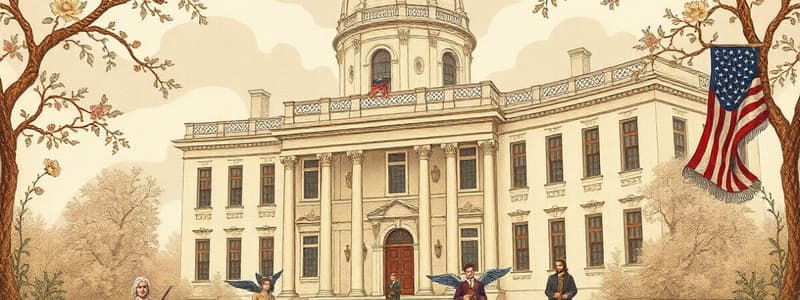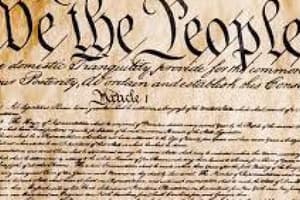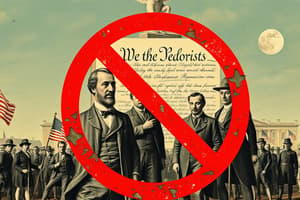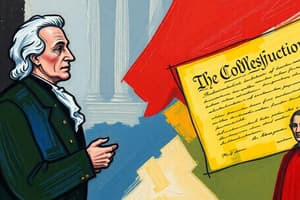Podcast
Questions and Answers
The Constitution was drafted in 1787 but not ratified until 1788, after 9 out of 13 states approved it, marking the creation of the first two major political parties: the ______ and the Anti-Federalists.
The Constitution was drafted in 1787 but not ratified until 1788, after 9 out of 13 states approved it, marking the creation of the first two major political parties: the ______ and the Anti-Federalists.
Federalists
Leading Federalists, like Alexander Hamilton, James Madison, and John Jay, wrote 'The ______ Papers' to advocate for a stronger central government.
Leading Federalists, like Alexander Hamilton, James Madison, and John Jay, wrote 'The ______ Papers' to advocate for a stronger central government.
Federalist
The Anti-Federalists were concerned that the Constitution could potentially take away people's ______.
The Anti-Federalists were concerned that the Constitution could potentially take away people's ______.
rights
The promise of a Bill of ______ helped to appease the Anti-Federalists and led to the ratification of the Constitution.
The promise of a Bill of ______ helped to appease the Anti-Federalists and led to the ratification of the Constitution.
George Washington was sworn in as the first ______ of the United States in April 1789.
George Washington was sworn in as the first ______ of the United States in April 1789.
The main point of disagreement between the Federalists and Anti-Federalists was the size and strength of the central ______.
The main point of disagreement between the Federalists and Anti-Federalists was the size and strength of the central ______.
The supporters of the Federalists were mainly ______ merchants, while the Anti-Federalists garnered support from small farmers.
The supporters of the Federalists were mainly ______ merchants, while the Anti-Federalists garnered support from small farmers.
The debate between the Federalists and the Anti-Federalists ultimately led to the inclusion of the Bill of ______.
The debate between the Federalists and the Anti-Federalists ultimately led to the inclusion of the Bill of ______.
Flashcards
Ratification of the Constitution
Ratification of the Constitution
Approved the Constitution of the United States, leading to its official adoption.
Federalists and Anti-Federalists
Federalists and Anti-Federalists
The first two major political parties in the United States, formed during the debate over the Constitution.
Federalists
Federalists
Supporters of the Constitution, advocating for a strong central government with shared power between federal and state levels.
Anti-Federalists
Anti-Federalists
Signup and view all the flashcards
The Federalist Papers
The Federalist Papers
Signup and view all the flashcards
Key Difference between Federalists and Anti-Federalists
Key Difference between Federalists and Anti-Federalists
Signup and view all the flashcards
Bill of Rights
Bill of Rights
Signup and view all the flashcards
Impact of the Federalist-Anti-Federalist Debate
Impact of the Federalist-Anti-Federalist Debate
Signup and view all the flashcards
Study Notes
Ratifying the Constitution
- The Constitution was drafted in 1787 but not ratified until 1788, after 9 out of 13 states approved it.
- The Constitution's ratification created the first two major political parties: the Federalists and the Anti-Federalists.
- The Federalists supported the Constitution and a strong central government, while the Anti-Federalists opposed it and favored a weaker central government.
- The Anti-Federalists believed the Articles of Confederation needed fixing but that the Constitution went too far.
- Leading Federalists, like Alexander Hamilton, James Madison, and John Jay, wrote "The Federalist Papers," a series of newspaper articles advocating for a stronger central government and the new Constitution.
- "The Federalist Papers" are considered some of the best defenses of Republican democracy.
- Anti-Federalists, like George Mason, Patrick Henry, and Samuel Adams, were concerned about the Constitution potentially taking away people's rights.
- To appease the Anti-Federalists, the Federalists agreed to add a Bill of Rights to the Constitution.
- With the promise of the Bill of Rights, state conventions began ratifying the Constitution, and New Hampshire became the ninth state to ratify, making it officially adopted.
- George Washington was sworn in as the first president in April 1789.
- The Bill of Rights was finished in September 1789 and ratified in December 1791.
Federalists vs. Anti-Federalists
- Federalists:
- Favored the Constitution.
- Supported a strong central government and federalism (shared power between federal and state governments).
- Believed in a large central government.
- Their supporters were mainly wealthy merchants.
- Anti-Federalists:
- Opposed the Constitution.
- Favored a weaker central government and more power for the states.
- Believed in a small central government.
- Their supporters were mainly small farmers.
Key Differences
- The main point of disagreement between the Federalists and Anti-Federalists was the size and strength of the central government.
Impact
- The debate between the Federalists and the Anti-Federalists led to the inclusion of the Bill of Rights, which safeguards individual liberties and guaranteed essential freedoms.
- The establishment of the Federalist and Anti-Federalist parties marked the beginning of political parties in the United States.
Additional Points
- The Articles of Confederation, the first governing document of the newly formed United States, established a weak central government.
- The Federalists believed that the Articles of Confederation were too weak and unable to effectively govern the country.
- The Anti-Federalists feared that a strong central government would become too powerful and oppressive, similar to the British monarchy they had just overthrown.
- The debate surrounding the ratification of the Constitution was a crucial moment in American history, shaping the structure and principles of the new nation.
Studying That Suits You
Use AI to generate personalized quizzes and flashcards to suit your learning preferences.




